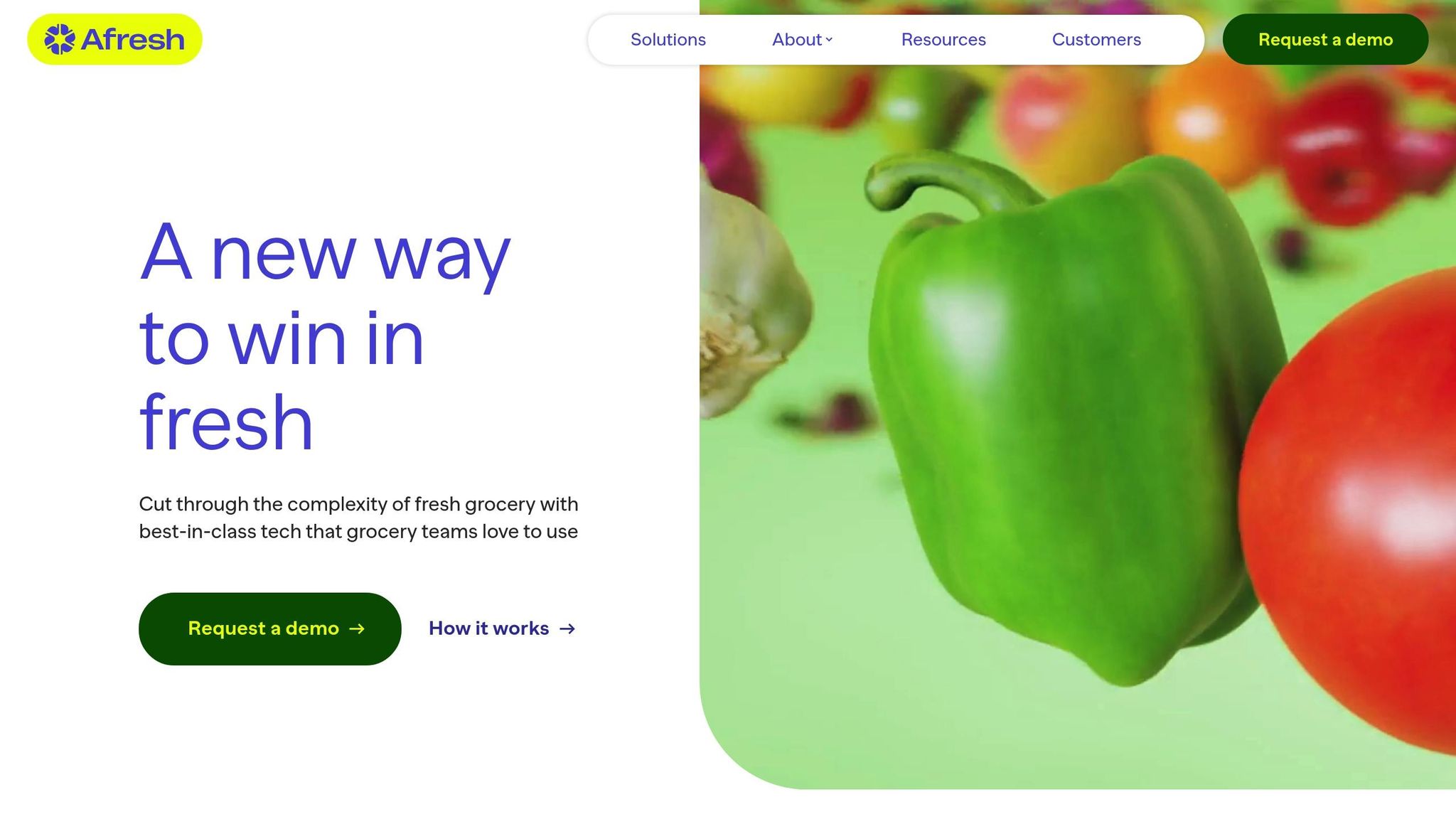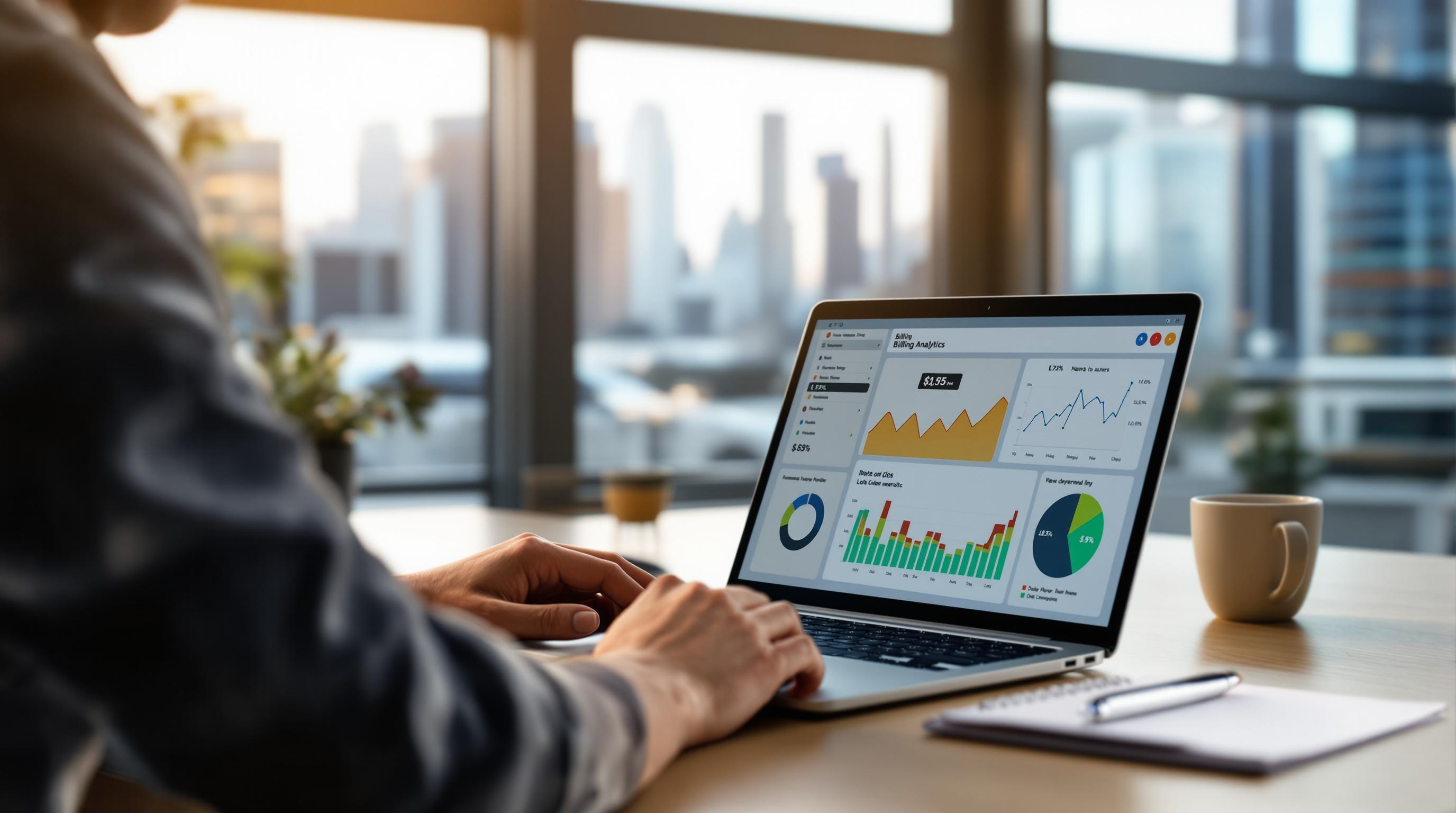Managing perishable inventory is tough. Short shelf lives, unpredictable demand, and strict regulations make it a challenge. Traditional methods like manual forecasting often lead to overstocking, understocking, and waste. Enter AI: a smarter way to handle these issues.
Here’s how AI helps:
- Better Forecasting: AI predicts demand using real-time data like weather, events, and consumer trends.
- Less Waste: Dynamic pricing and smart shelf-life tracking reduce spoilage.
- Lower Costs: AI optimizes purchasing, transportation, and energy use.
- Efficient Labor: Automation frees up employees for other tasks.
While AI requires upfront investment and technical know-how, its ability to cut waste and improve accuracy makes it a powerful tool for businesses handling perishable goods. A hybrid approach - mixing old and new systems - can ease the transition.
Work On Climate - Afresh: Towards a Sustainable Food Supply Chain Powered by AI (Volodymyr Kuleshov)

1. Standard Perishable Inventory Management
Managing perishable inventory the traditional way often involves manual processes and analyzing historical data. While this approach has been widely used, it struggles to keep up as businesses grow and markets shift. These challenges highlight the need for more advanced methods, which we’ll explore later.
Forecast Accuracy
Traditional forecasting methods rely heavily on historical data and human expertise, often managed through spreadsheets. These systems use manual, rule-based programming tied to sales forecasts and market trends.
But here’s the problem: these methods often fall short in accuracy, especially when dealing with perishable goods. With their short shelf lives and a host of unpredictable factors, these items require highly precise predictions. Unlike machine learning algorithms that can uncover hidden patterns and improve through feedback, rule-based systems need every rule to be predefined and explicitly programmed.
Waste Reduction
Because traditional methods are rigid, they often lead to forecasting errors. This can result in either overstocking, which causes spoilage, or understocking, which leads to missed sales opportunities.
Cost Control
Cost control in these systems is largely reactive. Businesses often rely on adjusting after losses are incurred and maintaining strong customer relationships to offset inefficiencies.
These challenges make a strong case for exploring advanced, AI-driven solutions that can address these shortcomings effectively.
2. AI-Driven Perishable Inventory Management
Traditional systems often struggle with forecasting and waste management, especially when dealing with perishable goods. AI steps in as a game-changer, using machine learning, real-time data, and predictive analytics to manage inventory more effectively. Unlike older methods that rely on static rules and past trends, AI adapts on the fly to changing conditions - making it a perfect fit for items with short shelf lives. This dynamic approach directly addresses the limitations of traditional systems.
Forecast Accuracy
AI-powered tools enhance forecasting by analyzing multiple data sources simultaneously. These systems take into account weather conditions, seasonal patterns, local events, and consumer behavior to predict demand with precision.
For example, they can identify connections like rising ice cream sales during hot weather or increased demand for certain produce around holidays. Plus, AI systems continuously refine their predictions using feedback loops, learning from actual outcomes to improve future forecasts.
What really sets AI apart is its real-time integration. Instead of relying solely on historical sales data, AI incorporates live updates from suppliers, transportation networks, and even social media trends. This allows businesses to adjust demand forecasts instantly as conditions change.
Waste Reduction
AI tackles waste by using dynamic pricing algorithms and optimizing shelf-life management. It adjusts prices based on factors like remaining shelf life, demand, and inventory levels. For example, items nearing expiration are automatically marked down to encourage sales before they spoil.
With smart rotation systems, AI ensures proper first-in-first-out practices by tracking each item throughout its lifecycle. Using computer vision, these systems can even assess the visual quality of produce, flagging items that need attention before they go bad.
AI also fine-tunes reordering processes, predicting the right time and quantity to restock based on inventory levels, demand forecasts, and supplier timelines. This precision helps avoid both overstocking, which leads to spoilage, and understocking, which results in missed sales opportunities.
Labor Efficiency
AI automates many tasks that previously required manual effort. For instance, automated reordering systems handle inventory monitoring and purchasing, allowing employees to focus on customer service and other strategic activities.
AI also supports predictive maintenance for refrigeration and storage equipment, identifying potential issues before they become costly breakdowns. This proactive monitoring helps prevent inventory loss due to equipment failure.
Additionally, AI improves staff scheduling by predicting peak periods and aligning schedules with delivery times. This ensures adequate coverage during busy times while avoiding unnecessary labor costs during slower periods.
Cost Control
AI helps businesses save money by making smarter purchasing decisions. It ensures that inventory is bought at the right time and in the right quantities, avoiding unnecessary expenses.
Transportation optimization is another area where AI shines. It reduces logistics costs by planning efficient delivery routes, taking into account traffic, weather, and delivery priorities. This minimizes fuel consumption and reduces the time products spend in transit.
AI also provides detailed analytics on purchasing patterns, waste rates, and supplier performance, enabling businesses to negotiate better terms with suppliers. This data-driven approach ensures partnerships with reliable vendors for essential perishable goods.
Lastly, AI optimizes energy costs for storage facilities. By adjusting temperature and humidity controls based on inventory needs, external weather, and energy prices, it minimizes utility expenses while preserving product quality.
sbb-itb-01010c0
Pros and Cons
Here’s a breakdown of the trade-offs between traditional and AI-driven inventory systems. Each approach comes with its own strengths and challenges, catering to different business needs.
Traditional systems are known for their simplicity and lower upfront costs. However, they rely heavily on manual processes and historical data, which can lead to less accurate forecasts and higher spoilage rates. On the other hand, AI-driven systems use advanced algorithms and real-time data to improve forecasting and reduce waste. But these systems often demand a significant initial investment, technical infrastructure, and ongoing maintenance.
| Criteria | Traditional Methods | AI-Driven Methods |
|---|---|---|
| Implementation Cost | Lower upfront costs | Higher initial investment due to advanced technology |
| Technical Complexity | Straightforward, manual processes | Complex algorithms requiring technical expertise |
| Forecasting Accuracy | Dependent on historical data, which may limit precision | Real-time data enhances forecasting capabilities |
| Waste Reduction | Higher spoilage due to manual oversight | Data-driven strategies minimize waste effectively |
| Labor Requirements | Requires significant manual input | Automates tasks, freeing staff for strategic roles |
| Adaptability | Slower to respond to market changes | Adapts in real time to market dynamics |
| Data Dependency | Relies on basic historical data | Needs high-quality, comprehensive data |
| ROI Timeline | Faster but modest returns | Longer timeline with potential for greater benefits |
| Scalability | Difficult to scale efficiently | Built for scalability across multiple locations |
| Maintenance | Low maintenance needs | Requires regular updates and technical support |
Given these contrasts, many businesses are opting for hybrid systems. These combine the cost-effectiveness and simplicity of traditional methods with the advanced capabilities of AI. This blended approach allows companies to improve efficiency while managing costs and adapting to market demands.
Conclusion
Managing perishable inventory with the help of AI opens up new possibilities for businesses dealing with time-sensitive products. While traditional methods may seem simpler and come with lower upfront costs, they often struggle to keep up in a market that demands real-time decisions and accurate forecasting to cut waste and boost profitability.
AI systems shine in areas like forecasting, reducing waste, and scaling operations. They thrive on real-time data, adapting quickly to shifts in market conditions and offering solutions that traditional methods simply can't match.
A smart way forward could be a hybrid approach - gradually blending AI with existing processes. This allows businesses to embrace innovation while staying grounded in familiar operations, even if it comes with higher initial costs and some technical hurdles.
For successful implementation, it’s critical to align AI tools with your specific operational challenges and focus on achieving measurable returns on investment.
Companies like The B2B Ecosystem offer AI tools, such as the AI Process Optimizer, along with consulting services designed to modernize workflows and enhance efficiency. By integrating data-driven solutions into your inventory strategy, you can secure a competitive edge in the market.
Whether you stick with traditional methods, fully embrace AI, or opt for a hybrid model, the key is to ensure your inventory management strategy aligns with your business goals, operational needs, and market dynamics. As the industry leans more toward data-driven solutions, now is the perfect time to explore how AI can reshape your operations for the better.
FAQs
How does AI enhance demand forecasting for perishable inventory compared to traditional methods?
AI brings a new level of precision to demand forecasting for perishable goods by leveraging machine learning to analyze diverse factors like historical sales, seasonal patterns, and the effects of promotions. Unlike older, static models, AI adjusts to shifting trends and processes complex data in real time.
This flexible approach can cut forecasting errors by 20–50%, enabling businesses to better manage inventory, reduce waste, and prevent stockouts. With its ability to learn and refine predictions over time, AI delivers more reliable forecasts, even in rapidly changing or uncertain market conditions.
What are the upfront costs and technical needs for using AI in perishable inventory management?
Adopting AI for managing perishable inventory in the U.S. comes with an initial investment typically ranging from $20,000 to $100,000. This amount usually covers essentials like hardware, software licenses, system integration, and employee training. For smaller businesses, ongoing costs for maintenance and updates can run between $1,000 and $5,000 per month.
On the technical side, setting up AI involves using high-performance software, compatible hardware, and a solid data infrastructure. This combination allows AI algorithms to perform tasks such as predictive analytics and automation, which are key to improving forecasting accuracy and streamlining inventory management.
How can businesses transition to a hybrid inventory management model using AI?
To make the shift to a hybrid inventory management model that includes AI, businesses should first take a close look at their current processes. The goal is to pinpoint where AI can make the biggest impact - think demand forecasting, real-time tracking, and inventory optimization.
A gradual rollout works best. By integrating AI tools step by step with existing systems, companies can avoid major disruptions and ensure a smoother transition. Prioritize predictive analytics and automation to sharpen decision-making and make operations more efficient.
Don’t overlook the importance of training your team on these new tools and keeping a close eye on how the systems perform. Over time, this strategy can result in more precise forecasts, less waste, and a better balance between supply and demand.


